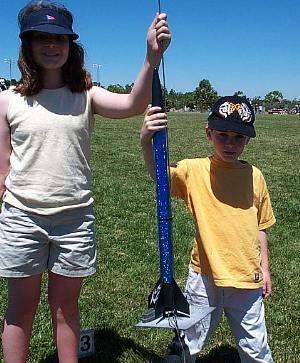 Brief:
Brief:
The Blue Ninja is a very basic four-fin rocket in the Estes E2X line, with one special feature, its a big rocket, using 24mm motors. Like all the E2X kits it builds quickly and easily without painting, using plastic parts except for the body tubes. The completed rocket sports a reflective blue finish and a big, powerful look that is a big hit with the younger rocketeers (and some of the older ones!) The completed rocket is over 31 inches tall and weighs a respectable 145 grams (5.1 oz.)
Construction:
This kit is entirely typical of Estes E2X kits. It arrived in a bag with all parts present and accounted for. The two body tubes immediately catch the eye. They are 12'' and 8'' inches long and over 1.6 inches in diameter (BT-60). They are also wrapped in a reflective, sparkling covering (Estes calls it “prismatic” that gives the Blue Ninja it's distinctive look. The nosecone, fin can, fins and tube connector are all black plastic, and seemed well molded. Surfaces are generally smooth, with a nice, 'satin' finish. The fits are good and required only a little trimming with the hobby knife.
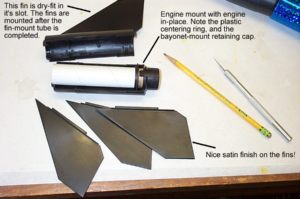 The most interesting part of the Blue Ninja construction is the engine mount, which is a little different that other Estes kits. The rear 5 inches of the rocket body is a molded plastic 'unit' in two halves. In addition to slots for the fin tabs, this unit supports the engine tube and provides a mount for the engine-retention cap. A plastic centering ring (of sorts) fits over one end of the paper motor tube. This ring fits into tabs inside the fin mount. The other end of the motor tube rests in a socket at the upper end of the fin mount unit. The top half of the fin-mount unit glues in place with plastic cement. A standard size 24mm motor like the D12 or C11 will protrude about ½ inch from the end of the motor tube. A plastic cap restrains the motor and hides it, giving a nozzle-like styling to the end of the rocket. This cap twists into place with a bayonet mount, and has appeared on several Estes E2X kits. It’s very easy and effective to use, if a bit heavier than a standard motor clip. (It may be possible to move the motor block forward to accommodate the longer E9 motors. I didn’t think of it at the time but I believe the motor tube is long enough. According to Rocksim this kit ought to fly well on those long-burning motors).
The most interesting part of the Blue Ninja construction is the engine mount, which is a little different that other Estes kits. The rear 5 inches of the rocket body is a molded plastic 'unit' in two halves. In addition to slots for the fin tabs, this unit supports the engine tube and provides a mount for the engine-retention cap. A plastic centering ring (of sorts) fits over one end of the paper motor tube. This ring fits into tabs inside the fin mount. The other end of the motor tube rests in a socket at the upper end of the fin mount unit. The top half of the fin-mount unit glues in place with plastic cement. A standard size 24mm motor like the D12 or C11 will protrude about ½ inch from the end of the motor tube. A plastic cap restrains the motor and hides it, giving a nozzle-like styling to the end of the rocket. This cap twists into place with a bayonet mount, and has appeared on several Estes E2X kits. It’s very easy and effective to use, if a bit heavier than a standard motor clip. (It may be possible to move the motor block forward to accommodate the longer E9 motors. I didn’t think of it at the time but I believe the motor tube is long enough. According to Rocksim this kit ought to fly well on those long-burning motors).
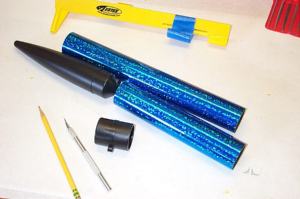 The plastic fins glue to the plastic fin-mount unit with plastic cement (you get the idea) The fins have short tabs to align them and perhaps provide a bit of strength. I suspect that these fins could pop off in a hard landing, but so far ours have stayed on (despite one landing on pavement.) It’s pretty hard to mess-up these fins. The biggest risk is that you will get plastic cement on the nice smooth surface and mar it, but that can be avoided with simple precautions.
The plastic fins glue to the plastic fin-mount unit with plastic cement (you get the idea) The fins have short tabs to align them and perhaps provide a bit of strength. I suspect that these fins could pop off in a hard landing, but so far ours have stayed on (despite one landing on pavement.) It’s pretty hard to mess-up these fins. The biggest risk is that you will get plastic cement on the nice smooth surface and mar it, but that can be avoided with simple precautions.
The completed fin can fits into the smaller of the two body tubes (again with plastic cement), and the two tubes are connected with a plastic coupler. The coupler is also the mounting point for the shock-cord.
The shock-cord is ¼ inch elastic, both wider and longer than one would expect from Estes (bravo!). Nevertheless I added a length of Kevlar tether, and strengthened the top inch of the body tube with thin CA to protect against “zippers”. The standard 18 in. plastic chute came pre-assembled. I attached it to the elastic about 7 inches from the nosecone.
The "Pros" for this kit are the easy, kid-friendly assembly (no CA or knives required). Instructions are typically Estes, which is to say easy to follow and well illustrated. The rocket feels quite sturdy, but if you use plastic cement as recommended there could be some separated parts after hard landings.
Finishing:
The only finish step is the application of stick-on decals, the large "Blue Ninja" on the rocket body and vaguely oriental designs to the fins. While effortless, the finish of this rocket is one of its strong selling points. It's a sharp-looking rocket right-out of the box, which was important for my 7 year old.
Construction Rating: 4 out of 5
Flight:
To date we have only flown the rocket on C11-3 motors (small fields and strong winds). Rocksim puts apogee with that impulse around 300 feet, and that seems about right. Boost has always been straight and deployment close to apogee. The rocket comes off the pad slowly and looks large and impressive in flight. A D12-5 flight is predicted to go to 700 feet. This ought to be a very predictable rocket, so I fully expect those flights to be very successful too. Estes recommends a 3 second delay on the D12, but Rocksim shows the D12-5 to be the better choice. These E2X rockets generally are built right to the predicted weight, so the Rocksim performance ought to be accurate.
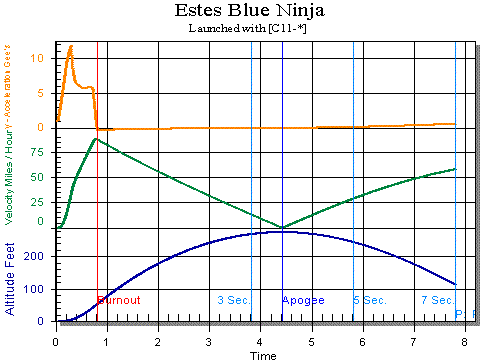
The motor-retention cap extends beyond the end of the motor a bit to create a "nozzle" effect. These caps make prep somewhat easier, and look better that a metal hook, but it is a bit of a reach to get the igniter properly secured in the motor nozzle. We had a couple of misfires caused by igniters that dropped out or broke. Not a big deal, but something to think about when you prep this rocket.
On the last flight the prismatic blue wrap started to unwind from the body tube. It’s a small flaw easily repaired.
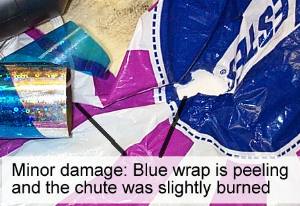 Recovery:
Recovery:
The Blue Ninja recovers on a standard Estes plastic 18in chute. This chute has worked well for us, in terms of size and decent rate. On the last flight the chute suffered some melting and burn holes, but brought the rocket back just fine. The body tube is wide and long, so sealing it with wadding is difficult. I was using Rogue Permawadding, which was undamaged, but obviously some of the "hot stuff" got by.
Flight Rating: 4 out of 5
Summary:
This is a fine kit for beginners, and ought to be a breeze for anyone with plastic model experience. The flights are impressive and dependable on the recommended engines. There is no balsa in this kit, and it is really not so much “built” as “assembled”. I usually prefer a more traditional kit, but I can appreciate what Estes is doing here. I bought this kit for my kids, principally my seven year old. That the Blue Ninja is “easy-to-build” is a nice thing for him, but the most important feature is that it’s “easy to get right”. I may find the “made-by-Cub Scouts” look kind of charming, but he is embarrassed by it. I’ve also seen beginners discouraged by the poor flying characteristics of their early attempts. My kids love to fly this rocket. They built it, it’s big, it flies well, and they get admiring glances when they take it to the pad. I think this kit is going to give a lot of beginners a good first experience in rocketry, and encourage them to continue on.
Overall Rating: 4 out of 5

 Brief:
Brief: The most interesting part of the Blue Ninja construction is the engine mount, which is a little different that other Estes kits. The rear 5 inches of the rocket body is a molded plastic 'unit' in two halves. In addition to slots for the fin tabs, this unit supports the engine tube and provides a mount for the engine-retention cap. A plastic centering ring (of sorts) fits over one end of the paper motor tube. This ring fits into tabs inside the fin mount. The other end of the motor tube rests in a socket at the upper end of the fin mount unit. The top half of the fin-mount unit glues in place with plastic cement. A standard size 24mm motor like the D12 or C11 will protrude about ½ inch from the end of the motor tube. A plastic cap restrains the motor and hides it, giving a nozzle-like styling to the end of the rocket. This cap twists into place with a bayonet mount, and has appeared on several Estes E2X kits. It’s very easy and effective to use, if a bit heavier than a standard motor clip. (It may be possible to move the motor block forward to accommodate the longer E9 motors. I didn’t think of it at the time but I believe the motor tube is long enough. According to Rocksim this kit ought to fly well on those long-burning motors).
The most interesting part of the Blue Ninja construction is the engine mount, which is a little different that other Estes kits. The rear 5 inches of the rocket body is a molded plastic 'unit' in two halves. In addition to slots for the fin tabs, this unit supports the engine tube and provides a mount for the engine-retention cap. A plastic centering ring (of sorts) fits over one end of the paper motor tube. This ring fits into tabs inside the fin mount. The other end of the motor tube rests in a socket at the upper end of the fin mount unit. The top half of the fin-mount unit glues in place with plastic cement. A standard size 24mm motor like the D12 or C11 will protrude about ½ inch from the end of the motor tube. A plastic cap restrains the motor and hides it, giving a nozzle-like styling to the end of the rocket. This cap twists into place with a bayonet mount, and has appeared on several Estes E2X kits. It’s very easy and effective to use, if a bit heavier than a standard motor clip. (It may be possible to move the motor block forward to accommodate the longer E9 motors. I didn’t think of it at the time but I believe the motor tube is long enough. According to Rocksim this kit ought to fly well on those long-burning motors). The plastic fins glue to the plastic fin-mount unit with plastic cement (you get the idea) The fins have short tabs to align them and perhaps provide a bit of strength. I suspect that these fins could pop off in a hard landing, but so far ours have stayed on (despite one landing on pavement.) It’s pretty hard to mess-up these fins. The biggest risk is that you will get plastic cement on the nice smooth surface and mar it, but that can be avoided with simple precautions.
The plastic fins glue to the plastic fin-mount unit with plastic cement (you get the idea) The fins have short tabs to align them and perhaps provide a bit of strength. I suspect that these fins could pop off in a hard landing, but so far ours have stayed on (despite one landing on pavement.) It’s pretty hard to mess-up these fins. The biggest risk is that you will get plastic cement on the nice smooth surface and mar it, but that can be avoided with simple precautions.
 Recovery:
Recovery:

















P.J.B. (July 14, 2002)